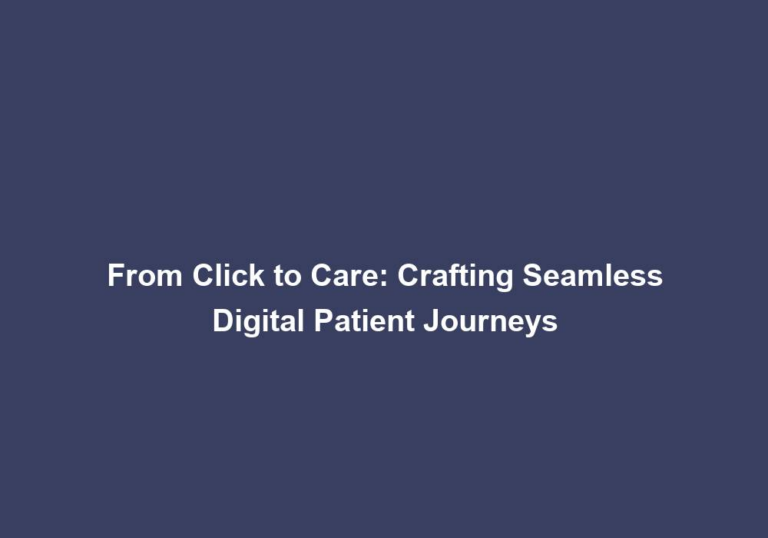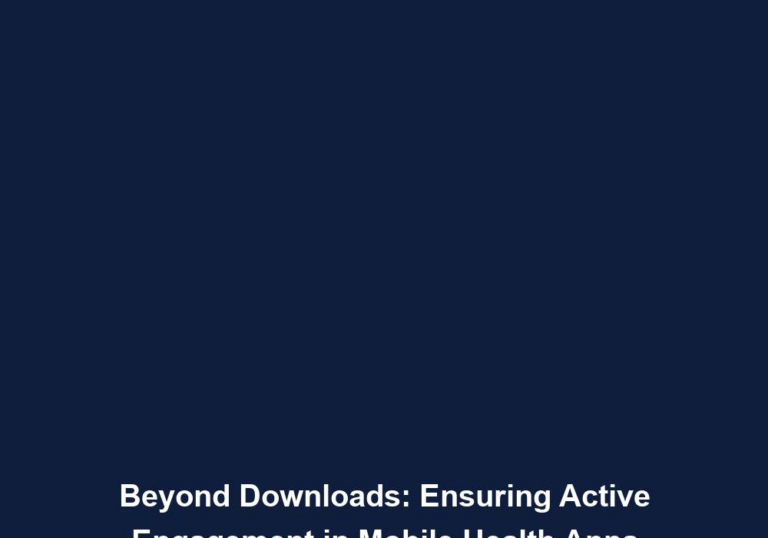Beyond Downloads: Ensuring Active Engagement in Mobile Health Apps
In today’s digital age, mobile health apps have gained immense popularity among individuals striving to improve their overall well-being. These apps offer a plethora of features and functionalities, ranging from tracking physical activity and monitoring sleep patterns to providing personalized health recommendations. However, the success of these apps extends far beyond the number of downloads they receive. Active engagement is crucial to ensure that users derive long-term benefits from these applications. In this article, we will explore strategies to enhance user engagement in mobile health apps, ultimately leading to better health outcomes.
Understanding the Importance of Active Engagement
While a high download count may initially seem impressive, it does not guarantee that users will actively engage with the app over time. Active engagement refers to the sustained usage of the app, where users regularly interact with its features, set goals, and track their progress. It is through active engagement that users develop habits and incorporate healthier choices into their daily routines, leading to improved health outcomes.
To fully grasp the significance of active engagement, it’s essential to understand its impact on user behavior and health outcomes. Research has shown that individuals who actively engage with mobile health apps are more likely to achieve their health goals and maintain a healthier lifestyle compared to those who passively download the app but do not utilize its features. Active engagement fosters a sense of commitment and accountability, empowering users to take control of their health and well-being.
Designing User-Friendly and Intuitive Interfaces
One of the fundamental aspects of enhancing user engagement is to design mobile health apps with user-friendly and intuitive interfaces. The easier it is for users to navigate through the app and access its features, the more likely they are to actively engage with it. Here are some best practices for designing user-friendly interfaces:
-
Simplicity: Keeping the interface clean and clutter-free is crucial to prevent overwhelming users with unnecessary visual elements. Use clear and concise language to guide users through the app’s functionalities. Avoid technical jargon and prioritize simplicity to cater to users of all technical abilities.
-
Consistency: Maintaining consistency in design elements, such as color schemes, fonts, and icons, throughout the app, is essential. Consistency helps users familiarize themselves with the interface quickly, reducing the learning curve and enhancing usability.
-
Usability Testing: Conducting usability testing is a valuable practice to identify any pain points or areas of confusion for users. Regularly gather feedback from users and make necessary improvements based on their suggestions. Usability testing allows developers to refine the app’s interface and enhance user experience.
-
Intuitive Navigation: Ensure that the app’s navigation is intuitive and logical, allowing users to navigate between sections effortlessly. Implement clear and easily accessible menus to help users find what they need quickly. Intuitive navigation reduces frustration and encourages users to explore all the features of the app.
By implementing these best practices, developers can create mobile health apps with interfaces that are welcoming, easy to understand, and intuitive to use. User-friendly interfaces not only enhance engagement but also contribute to a positive user experience, increasing the likelihood of sustained app usage.
Personalization and Customization
To keep users engaged, mobile health apps should offer personalized experiences and customization options. Users are more likely to stay engaged when they feel that the app understands their individual needs and preferences. Here are some strategies to incorporate personalization and customization:
-
User Profiles: Allowing users to create profiles where they can provide information about their health goals, preferences, and any specific requirements is key. Use this data to tailor the app’s recommendations and content to suit each user’s unique needs. By personalizing the app’s offerings, users feel a stronger connection and are more likely to engage consistently.
-
Goal Setting: Enabling users to set personalized health goals within the app is a powerful motivator. Provide them with the flexibility to track various metrics, such as steps taken, calories burned, or hours of sleep, based on their preferences and objectives. Setting achievable goals and tracking progress helps users stay motivated and engaged.
-
Notifications and Reminders: Implementing a notification system that sends personalized reminders and updates to users is an effective way to maintain engagement. This can include reminders for daily activities, progress updates, or motivational messages to encourage users to stay engaged with the app. Timely notifications help users stay on track and reinforce healthy habits.
-
Content Customization: Allowing users to customize the app’s content by selecting their areas of interest, such as nutrition, fitness, or mental health, enhances personalization. Curate personalized content recommendations based on their preferences, ensuring that the app delivers relevant and valuable information. Customized content keeps users engaged and provides them with a sense of ownership over their health journey.
By incorporating personalization and customization features, mobile health apps can offer tailored experiences that resonate with users’ individual needs and preferences. This level of personalization fosters a deeper connection between users and the app, increasing engagement and long-term usage.
Gamification and Social Engagement
Incorporating gamification elements and promoting social engagement can significantly impact user retention and active usage. People are naturally motivated by competition, rewards, and the sense of social connectedness. Here’s how you can leverage gamification and social engagement strategies:
-
Achievements and Badges: Implementing a system of achievements and badges that users can unlock as they reach specific milestones or goals provides a sense of accomplishment and motivates users to continue using the app. Recognizing users’ efforts and progress boosts engagement and encourages them to strive for more.
-
Challenges and Leaderboards: Creating challenges that users can participate in, either individually or with friends, adds an element of competition and motivation. Display leaderboards to foster a competitive spirit and encourage users to strive for better results. Challenges and leaderboards create a sense of community and inspire users to stay engaged to improve their rankings.
-
Social Sharing: Integrating social media sharing capabilities allows users to share their achievements, progress, or challenges with their friends and followers. This not only boosts engagement but also serves as a form of free marketing for the app. By sharing their successes, users can inspire others and create a supportive community around the app.
By incorporating gamification elements and promoting social engagement, mobile health apps can tap into users’ intrinsic motivation to actively engage and continue using the app. It creates a fun and interactive experience that fosters long-term engagement and enhances the overall user experience.
Continuous Improvement and Feedback Loop
To ensure long-term engagement, mobile health apps must continuously improve and iterate based on user feedback. Actively listening to users’ suggestions, concerns, and pain points and making necessary updates is crucial. Here’s how:
-
Feedback Mechanisms: Implementing feedback channels within the app, such as in-app surveys or contact forms, allows users to provide feedback easily. Encourage users to share their thoughts and actively respond to their inquiries and suggestions. Actively seeking user feedback shows users that their opinions are valued and helps developers understand their needs better.
-
Regular Updates: Continuously releasing updates that address bugs, improve performance, and introduce new features based on user feedback is essential. Regularly communicating these updates to users helps maintain their interest and confidence in the app. Updating the app demonstrates the developer’s commitment to delivering an exceptional user experience.
-
Data Analysis: Analyzing user data to identify patterns and trends is crucial for optimizing the app’s functionality and user experience. Use this information to gain insights into user behavior, preferences, and areas that may require improvement. Making data-driven decisions helps developers prioritize enhancements that have the most significant impact on user engagement.
By establishing a feedback loop and actively incorporating user feedback into app improvements, developers can create mobile health apps that continually evolve to meet user needs. This iterative process ensures that the app remains relevant, engaging, and valuable to users in the long run.
Conclusion
Beyond downloads, active engagement is vital for the success of mobile health apps. By designing intuitive interfaces, personalizing user experiences, incorporating gamification elements, and actively seeking user feedback, developers can create apps that foster long-term user engagement and ultimately contribute to improved health outcomes. Remember, the ultimate goal is to empower individuals to take control of their health and well-being by actively using these apps as valuable tools in their daily lives.







